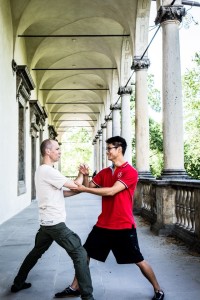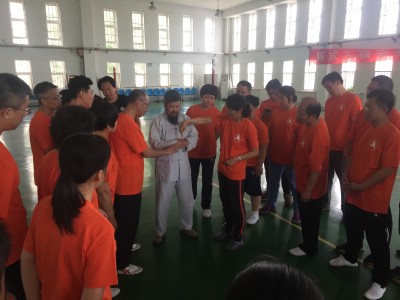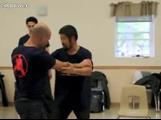To link movements together is to become double heavy. Instead of moving together, each body part must complete its’ designated role to complete a function. Desynchronized synchronization – first we must learn how to take our body apart before we can put it back together. Like a machine, the power only comes from every piece doing it’s job. One thing can only do one thing. The piston in an engine only moves up and down; it does not try to turn the wheel or to move the car forward. Within taijiquan, the machine does not fight. None of the actions of the body relate to fighting the opponent, only completing its’ designated job.
Within a one dimensional movement everything is connected. For example, as the hand moves forward in a push, the torso also moves forward, typically followed by the rear knee. In this way, everything moves together in order to generate power, this power is generated by strength and expressed through speed.
A two dimensional movement compounds the power of each body part by creating a non-moving piece. Each piece is able to successively ground off the last piece by creating a ‘wall’ to push off of. To create fewer or an unstable wall is to merge pieces together, resulting in power leaking out of the body or rebounding back. Power is dependent on the stability of the last piece. While we are learning to create this separation, our power is often not consistent enough to maintain the stretch. As we encounter power we revert back to a single dimensional push. A true two dimensional stretch is to maintain the separation despite obstacles.

The creation of the non-moving part is a stretch by definition. Power is a differential; most commonly it is a differential of space by using speed. Within taiji we are creating a differential using stability, with each piece not merging. To merge powers is to create an unstable wall
In the previous example of a push, a two dimensional movement would separate the arm from the body. As the arm pulls or pushes, the torso remains unaffected. The torso not moving creates a ‘wall’ that the arm is able to push off of.
To be able to move in this manner is to move like a rotary saw. With a rotary saw the blade does not move on its’ own. The blade only rotates and spins, while the saw is pushed onto the wood. The cutting of the wood does not have to do with the blade rotating, it has to do with the wood being pushed onto the blade, or the saw being pushed onto the wood. The saw must move independent of the blade rotation – if the blade moves forward it is unable to rotate. Similarly, the torso does not move, only remains upright and rotates. The legs move the body forward/backwards, while the arms cut.
Therefore we must find a method to define the separation of our movements. Separation of the body applies on both a macro and micro scale. Not only must we separate in the cardinal directions (top/bottom, left/right, front/back), but also differentiate the role of the hand from the role of the elbow; what the purpose of the front shoulder is vs. the rear shoulder, etc.
Relevant videos:
http://practicalmethod.com/2015/01/no-tossing-separated-movements-online-video-trailer/
http://practicalmethod.com/2014/06/dimensions-5-points-online-video-trailer/



